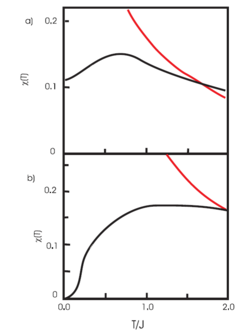It is commonly believed that for the understanding of the behaviour of large, macroscopic, objects at moderately high temperatures there is no need to invoke any genuine quantum entanglement. This is because decoherence effects arising from many particles interaction with the environment would destroy all quantum correlations.
In a series of papers [1-4] we have shown that this belief is fundamentally mistaken and that entanglement is crucial to correctly describe macroscopic properties of solids. Moreover, we demonstrated that macroscopic thermodynamical properties – such as internal energy, heat capacity or magnetic susceptibility – can reveal the existence of entanglement (i.e. are so called “entanglement witnesses) within solids in the thermodynamical limit even at moderately high temperatures. We found the critical values of physical parameters (e.g. the high-temperature limit and the maximal strength of magnetic field) below which entanglement exists in solids.
Detection of entanglement in magnetic solids, modelled by the xxx-Heisenberg spin-1/2 (a, top) and spin 1 (b, bottom) chains. The black solid curves are temperature dependences of the zero-field magnetic susceptibilities per particle and the red curves are “entanglement witnesses”. All points below of the intersection points to the left (below the critical temperatures) indicate the existence of entanglement in the solids.
[1] Č. Brukner and V. Vedral, Macroscopic Thermodynamical Witnesses of Quantum Entanglement, Preprint at quant-ph/0406040.
[2] Č. Brukner, V. Vedral and A. Zeilinger, Crucial Role of Quantum Entanglement in Bulk Properties of Solids, Phys. Rev. A 73, 012110 (2006).
[3] M. Wiesniak. V. Vedral and Č. Brukner, Magnetic Susceptibility as Macroscopic Entanglement Witness, New J. Phys. 7, 258 (2005).
[4] M. Wieśniak, V. Vedral, and Č. Brukner, Heat capacity as an indicator of entanglement, Phys. Rev. B 78, 064108 (2008).
Brukner Group

Caslav Brukner
Scientific & Deputy Executive DirectorGroup Leader+43 (1) 4277 - 72582

Luca Apadula
PhD Student

Eduardo Barbosa Oliveira
Visiting PhD Student

Carlo Cepollaro
PhD Student (Univie)

Anne-Catherine De la Hamette
PhD student (Univie)

Viktoria Sophia Kabel
PhD Student+43 (1) 4277 - 72580

Stefano Osnaghi
Post Doc (Univie)

Martin Johannes Renner
PhD Student (Univie)

Daniel Vanzella
Visiting Senior Scientist



